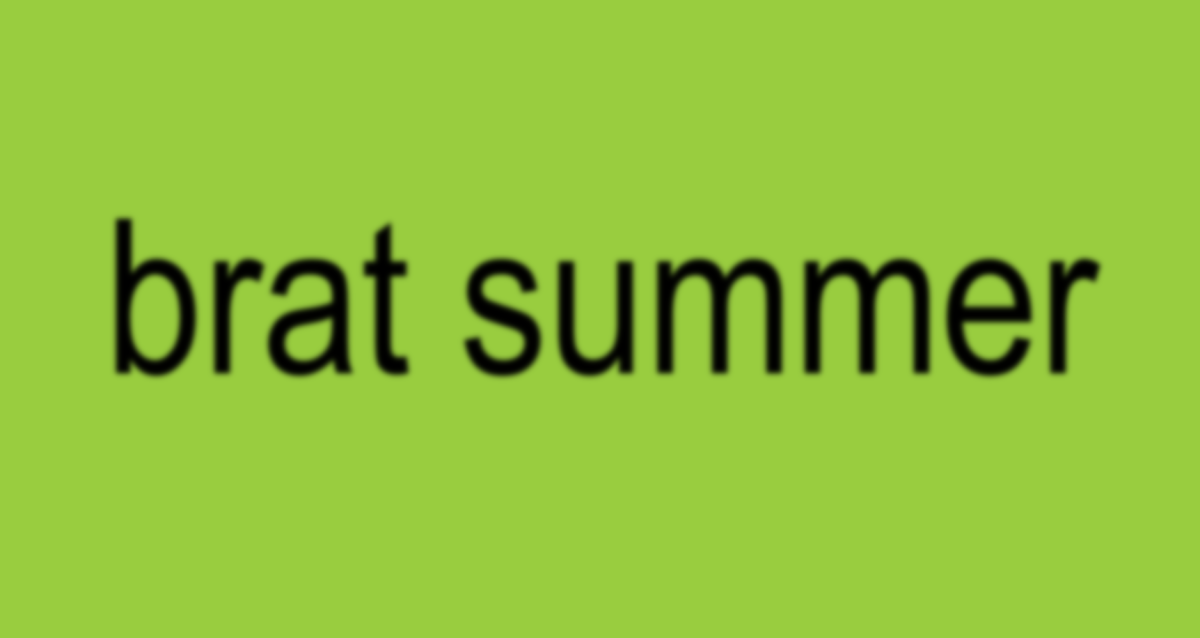One hex code among millions: #8ACE00.
Yet, it is the only one that managed to take the online community by storm this summer. If you happened to scroll through social media in recent months, you likely encountered this unassuming lime-green color with the word “brat” scrawled in the center in a nonchalantly pixelated manner, repeatedly filling your screen. What seemed like a random shade of green soon became a defining symbol of the season.
Charli XCX released her album “brat” on June 7, featuring a 15-song tracklist packed with her signature electro-pop beats. The album exudes both cool confidence and raw vulnerability. Taking to TikTok, Charli XCX defined a brat as someone “who feels herself but maybe also has a breakdown, but kind of, like, parties through it; is very honest, very blunt, a little bit volatile.” Through her interviews and social media presence, she made it clear that the album was not meant merely just to be another enjoyable listen. This was a generation-defining movement.
One of my favorite songs from the album is “Girl, so confusing featuring lorde.” Created to squash the rumors of mutual grudges between Charli XCX and Lorde over the past few years, this song represents a significant moment of reconciliation for both artists. With lyrics like, “Yeah, I don’t know if you like me/Sometimes I think you might hate me” and “Let’s work it out on the remix,” the singers explore the intricacies of female friendships and reconciliations.
Charli XCX’s promise of relatability and empowerment began prior to the album’s release. Building anticipation and setting the stage for the album’s arrival, the term “brat summer” was coined by Charli XCX a few weeks before the actual release of her album. As the album grew, so did the social media buzz around it with many fans posting about their own versions of “brat summer.” This was spread even wider with the trending of the “Apple dance” on TikTok, an easy-to-learn dance routine done to the music of the song “Apple.”
It wasn’t long before various organizations recognized the marketability of “brat summer” related advertisements. Food brands emphasized their “bratwurst” sausages, integrating the iconic neon green color associated with the album into their packaging. Bookstores curated shelves of books with the promise to evoke the “brat summer” vibe.
However, the most memorable advertisement came after the adoption of “brat summer” by Vice President Kamala Harris’s campaign for presidency. Following various mashups of Harris and the “brat” album going viral on social media, the campaign strategically decided to embrace the trend to connect with younger voters. By mid-July, Harris HQ’s X banner was eventually changed to the “brat” color, sporting “kamala hq” where the word “brat” used to be. The impact of the move was undeniable, with Harris opening up a 13-point advantage among voters 18–34 years old in comparison to former President Trump.
Like all viral phenomena do, “brat” was in no way shielded from backlash. As it was being praised for its free and defiant aesthetic, numerous people also commented on how it put being dirty and rebellious on a pedestal. In addition, many disapproved of the use of pop culture to promote political movements, stating that the two should be kept separate. While participating in the trends related with younger audiences, older audiences also cautioned the heavy use of memes at risk of being viewed as unserious. While ‘brat summer’ helped boost Harris’s popularity among young voters, it’s also important for the campaign to remember to maintain a clear boundary between professional and overly casual.
Whether or not approving or disapproving, “brat” has inarguably played a significant role in shaping the culture of 2024’s summer. As “brat” continues to be dissected and debated, its influence remains a testament to the important role pop culture plays in our modern society.



Charli XCX • Sep 30, 2024 at 3:04 pm
thanks for highlighting my album TJTODAY!!! Would love to come perform for you guys sometime !! <333333 Thanks so much sophia too!!!!